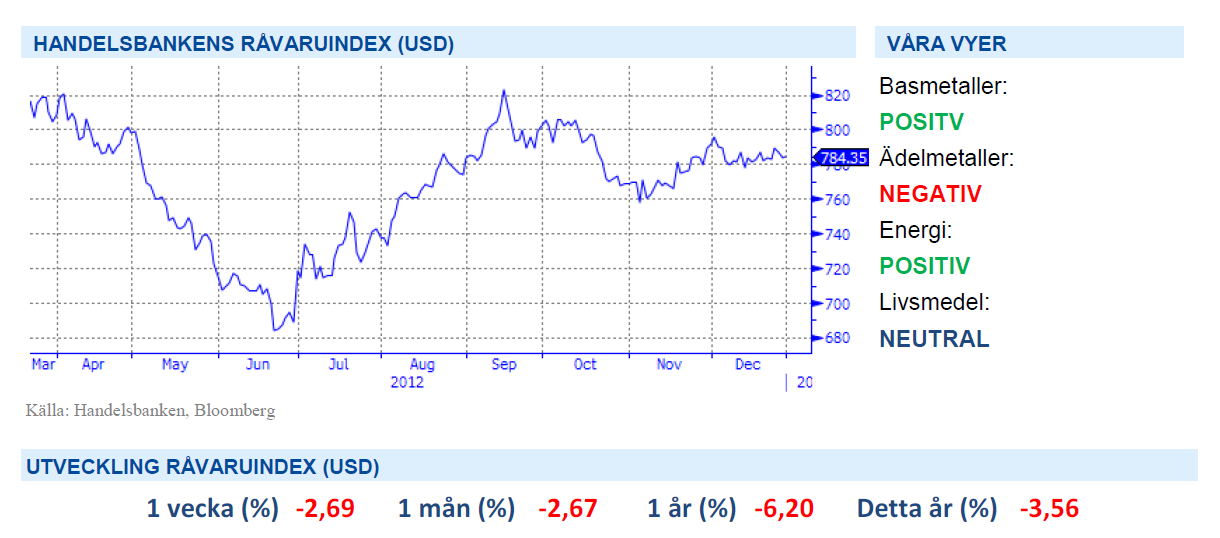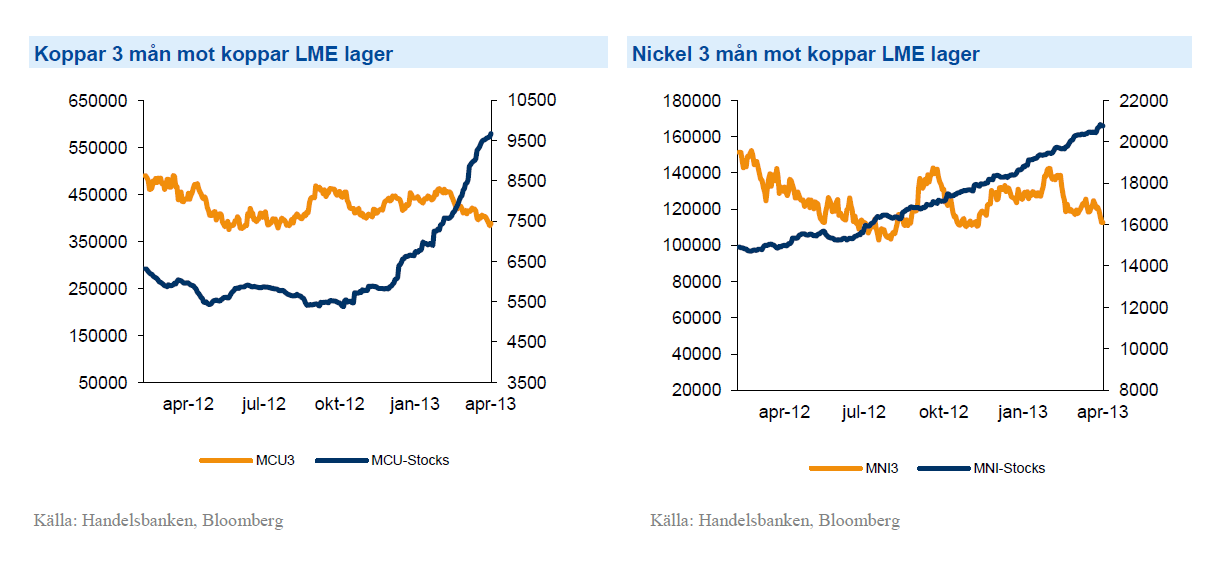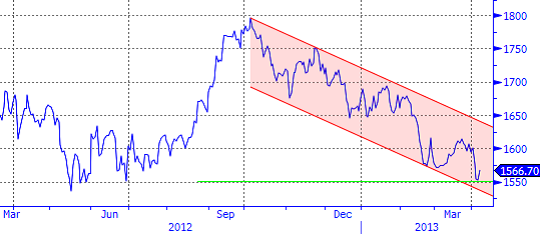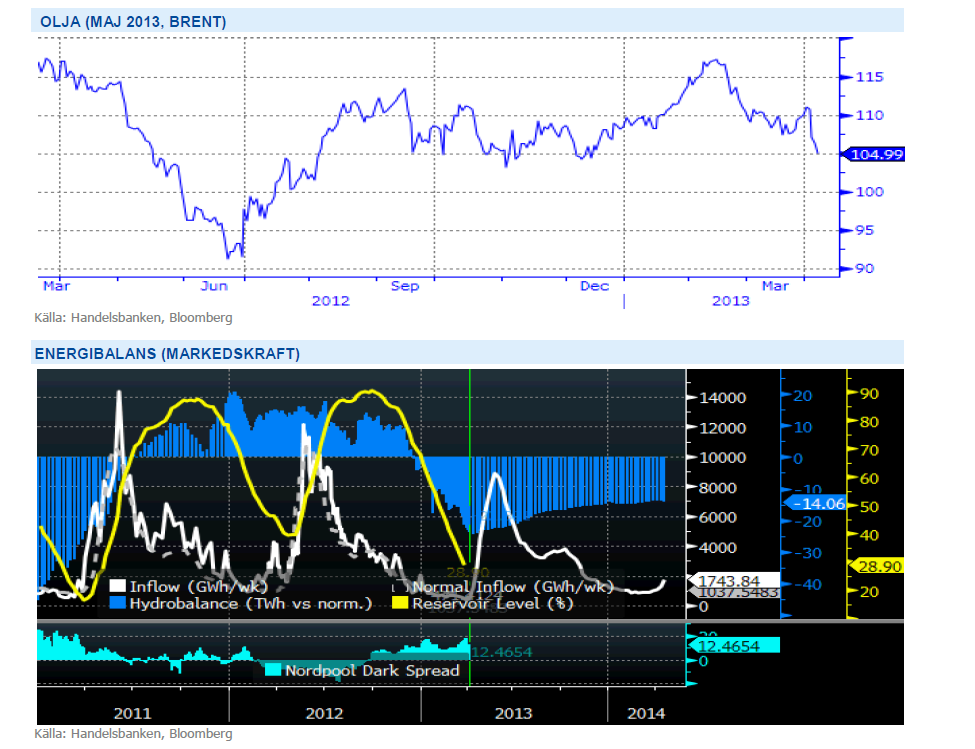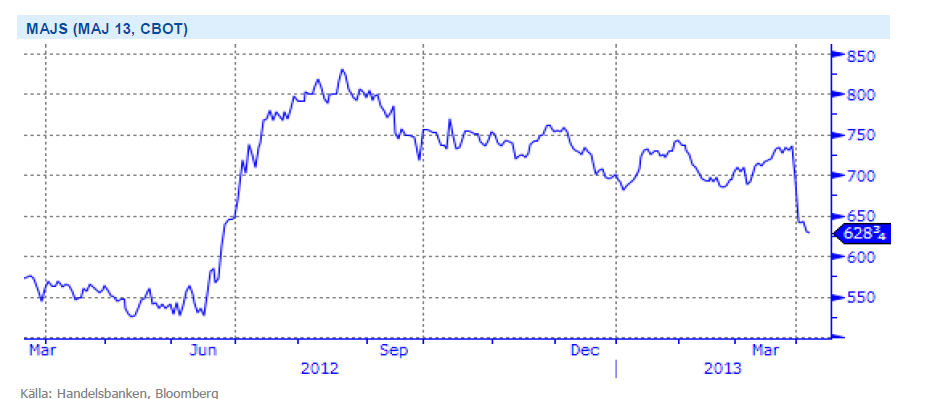Analys
SHB Råvarubrevet 5 april 2013

 Råvaror allmänt
Råvaror allmänt
Motig vecka för risktillgångar
Veckan har varit motig för risktillgångar i Europa. Den QE drivna amerikanska börsen fortsätter däremot att driva på konsumtionen i USA trots skattehöjningar. Inköpschefsindex i USA kom in på förvånansvärt låga nivåer och väcker vår oro för att vi missat något tecken i den till synes starka amerikanska återhämtningen. Den låga siffran var också en påminnelse om att USA haft ett starkt säsongsmönster där våren varit en besvikelse under de senaste åren. Under fredagen publicerades non-farm payrolls som visade på färre antal sysselsatta i USA (utanför jordbrukssektorn) än väntat vilket fick bland annat stärkte guldet och försvagade dollarn.
Även från Kina kom inköpschefsindex och denna var visserligen på 12 månaders högsta men fortfarande bara något över 50 strecket. Vi vill se det kinesiska indexet klättra upp mot 52-53 för att säga att återhämtningen där står på säker mark. Investeringar och konsumtion ser dock bra ut men kinaråvaror tyngs av myndigheternas ambitioner att begränsa prisuppgångar i fastigheter. Vår makrosyn på ett Kina i återhämtning är dock intakt och första kvartalets kinadata är alltid svårtolkad på grund av nyårsledigheten.
Efter den senaste tidens nedgångar på majs, vete och soja justerar vi vår vy för livsmedel till neutral.
Basmetallerna
Svag vecka för metallerna
Basmetallerna lägger en vecka bakom sig med återigen fallande priser. Volatila metallen nickel föll med 3,4 % medan koppar och aluminium tappade ca 2 % vardera. Veckans inköpschefsindex från Kina gav visst stöd men motarbetades av ytterligare uttalanden från myndigheterna om att begränsa prisuppgångarna på fastighetsmarknaden. Basmetallerna är tekniskt sett översålda och vi väntar oss en rekyl uppåt ganska snart.
I Chile, världens största producent, pågår sedan den 16:e mars en strejk bland hamnarbetarna vilken stoppar upp 9000 ton koppar varje dag. Kopparexporten har därmed minskat med 60 %. Samtidigt förbereder sig arbetarna i BHP Billiton och Anglo Americans koppargruvor för protester för förbättrade arbetsvillkor.
Metallerna tyngs fortsatt höga av lagernivåer (LME:s) där koppar och nickel ligger på historiskt höga nivåer.
Trots nedgången under veckan tror vi på högre priser på basmetaller och ser istället möjlighet till ”buy on dip”. Vi tror på: BASMET H
Ädelmetaller
Vi tror fortsatt på lägre guld
I veckan skickade vi ut ett trading case där vi följde upp vår tro på lägre guld. Under 2012 nådde guld sin högsta nivå 1794 USD/oz den 4e oktober när QE3 yran var som värst. Därefter har guldet hamnat i en fallande trend. Sedan vi initierade en handelsidé på fallande guld i mitten av februari har guldet fallit. Under mitten av mars kom dock ett trendbrott när oron kring Cypern åter väckte guldets klassiska status som en säker hamn vid oro i det finansiella systemet. Den oron har nu dragit förbi efter att risken för spridningseffekter till övriga svaga länder i Sydeuropa verkar låga.
Den globala återhämtningen sprider sig och den urstarka börsen driver investerare ut ur defensiva positioner såsom guld. Under februari och mars har guld motsvarande 6 % av en årsproduktion i gruvorna sålts ut av ETF-investerare. Guld är den mest tekniskt handlade råvaran. Nu har guldet åter börjat falla och står på ett mycket viktigt stöd på 1550 med fallhöjden ner till 1450. Uppåt tycker vi att en stopp på 1585 är att rekommendera. Denna strategi lämpar sig väl för en hävstångsprodukt då målkurs och stop ligger relativt snävt. För vår långsiktiga tro på ett lägre guldpris lämpar sig GULD S H, utan hävstång bäst.
Starkare dollar och högre räntor blir utmanande för guldet samtidigt som inflationen väntas vara låg under året. Vi tror på: GULD S H
Energi
El – en av de bästa råvarorna i år!
Oljan är fortsatt rangehandlad och föll under veckan efter att amerikanska lagersiffror ökat mot förväntan samtidigt som amerikanska sysselsättningssiffror kom in klart under förväntan. Vi har en tro på försiktigt högre oljepriser baserat på att OPEC försvarar prisintervallet 100-110 USD och en allt bättre världskonjunktur. Vi räknar således med att marknaden värderar detta som intressanta nivåer kliva in i olja igen.
El har varit en av de bästa råvarorna under året (+10%) och vi fortsätter tro på högre priser. Det har varit en väldigt torr väderlek under de två veckor som gått med lågt inflöde till vattenmagasinen och energibalansen har minskat ytterligare 2 TWh till -14TWh mot normal år (se blått nedan) samtidigt som det varit väldigt kallt för året.
Den råvarugrupp som är mest beroende av den globala konjunkturen är Energi och med en starkare konjunktur ser vi positivt på utvecklingen för denna sektor. Vi tror på: ENERGI H
Livsmedel
Vi byter vy till neutral
Vi har länge haft en starkt negativ syn på jordbruksråvarorna soja, vete och majs efter fjolårets svåra torka i USA som drev upp priserna rejält. Priserna har sedan långsamt fallit i takt med att vi har närmat oss det nya odlingsåret. Precis före påsk kom amerikanska jordbruksdepartementet med sin kvartalsrapport som visade på större lager än väntat. Störst skillnad var det för majsen som visade på 7 % större lager än väntat (5,4 miljoner bushel mot förväntade 5 miljoner). På två dagar föll priset på majs 14 % och är nu nere på nivåer före torkan. På kort sikt tror vi därför att risken för ytterligare ras är begränsad och byter syn på livsmedel till neutral. Det europeiska vetet (som är underliggande till våra certifikat) behåller sin styrka då kall väderlek försvårar för pågående vårsådd och även försenar utvecklingen för höstgrödorna. Mot hösten, givet en normal sommar, bör vi dock få se lägre vetepris med upptill 15-18%.
Kaffe (SHB Coffee) är den råvara i vårt råvaruindex som fallit mest sen årsskiftet (-12 %). Det finns fortfarande gott om kaffe på marknaden efter förra årets rekordskördar, dessutom ligger skörden i Brasilien ett par månader bort där fortsatt höga skördar väntas. Under senare delen av mars månad har vi sett en liten uppgång som följd av att Kenya minskat sin export av kaffebönor med 15 procent till länder som Tyskland, Sverige och USA. Dessutom visade siffror som kom i veckan på 17 procent lägre export än vid samma period tidigare år från Guatemala p. g. a. svampsjukdomarna som drabbat stora delar av Centralamerika. Under förutsättning att vi får ett normalt år utan dramatiska väderproblem och fortsatt goda skördar från de stora kaffeproducerande länderna ser vi priset på Arabica–kaffet att komma ligga på dagens nivåer fram till efter skörd.
Handelsbankens Råvaruindex
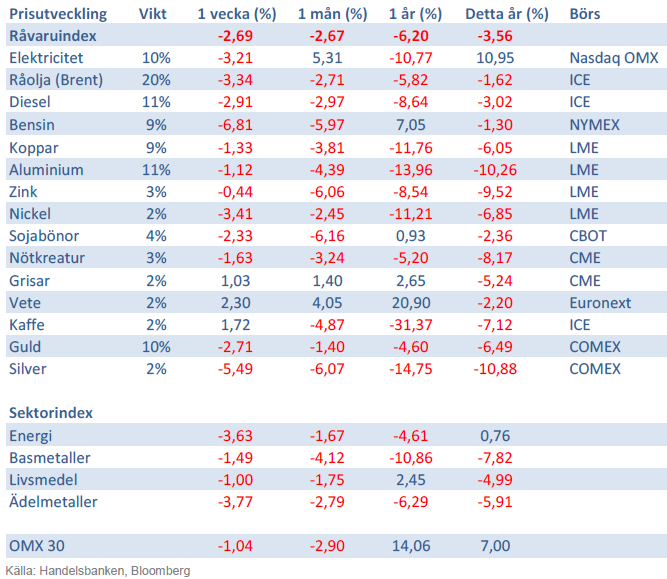
Handelsbankens råvaruindex består av de underliggande indexen för respektive råvara. Vikterna är bestämda till hälften från värdet av nordisk produktion (globala produktionen för sektorindex) och till hälften från likviditeten i terminskontrakten.
[box]SHB Råvarubrevet är producerat av Handelsbanken och publiceras i samarbete och med tillstånd på Råvarumarknaden.se[/box]
Ansvarsbegränsning
Detta material är producerat av Svenska Handelsbanken AB (publ) i fortsättningen kallad Handelsbanken. De som arbetar med innehållet är inte analytiker och materialet är inte oberoende investeringsanalys. Innehållet är uteslutande avsett för kunder i Sverige. Syftet är att ge en allmän information till Handelsbankens kunder och utgör inte ett personligt investeringsråd eller en personlig rekommendation. Informationen ska inte ensamt utgöra underlag för investeringsbeslut. Kunder bör inhämta råd från sina rådgivare och basera sina investeringsbeslut utifrån egen erfarenhet.
Informationen i materialet kan ändras och också avvika från de åsikter som uttrycks i oberoende investeringsanalyser från Handelsbanken. Informationen grundar sig på allmänt tillgänglig information och är hämtad från källor som bedöms som tillförlitliga, men riktigheten kan inte garanteras och informationen kan vara ofullständig eller nedkortad. Ingen del av förslaget får reproduceras eller distribueras till någon annan person utan att Handelsbanken dessförinnan lämnat sitt skriftliga medgivande. Handelsbanken ansvarar inte för att materialet används på ett sätt som strider mot förbudet mot vidarebefordran eller offentliggörs i strid med bankens regler.
Analys
Crude oil soon coming to a port near you

Rebounding along with most markets. But concerns over solidity of Gaza peace may also contribute. Brent crude fell 0.8% yesterday to $61.91/b and its lowest close since May this year. This morning it is bouncing up 0.9% to $62.5/b along with a softer USD amid positive sentiment with both equities and industrial metals moving higher. Concerns that the peace in Gaza may be less solid than what one might hope for also yields some support to Brent. Bets on tech stocks are rebounding, defying fears of trade war. Money moving back into markets. Gold continues upwards its strong trend and a softer dollar helps it higher today as well.

US crude & products probably rose 5.6 mb last week (API) versus a normal seasonal decline of 2.4 mb. The US API last night partial and thus indicative data for US oil inventories. Their data indicates that US crude stocks rose 7.4 mb last week, gasoline stocks rose 3.0 mb while Distillate stocks fell 4.8 mb. Altogether an increase in commercial crude and product stocks of 5.6 mb. Commercial US crude and product stocks normally decline by 2.4 mb this time of year. So seasonally adjusted the US inventories rose 8 mb last week according to the indicative numbers by the API. That is a lot. Also, the counter seasonal trend of rising stocks versus normally declining stocks this time of year looks on a solid pace of continuation. If the API is correct then total US crude and product stocks would stand 41 mb higher than one year ago and 6 mb higher than the 2015-19 average. And if we combine this with our knowledge of a sharp increase in production and exports by OPEC(+) and a large increase in oil at sea, then the current trend in US oil inventories looks set to continue. So higher stocks and lower crude oil prices until OPEC(+) switch to cuts. Actual US oil inventory data today at 18:00 CET.
US commercial crude and product stocks rising to 1293 mb in week 41 if last nights indicative numbers from API are correct.

Crude oil soon coming to a port near you. OPEC has lifted production sharply higher this autumn. At the same time demand for oil in the Middle-East has fallen as we have moved out of summer heat and crude oil burn for power for air-conditioning. The Middle-East oil producers have thus been able to lift exports higher on both accounts. Crude oil and condensates on water has shot up by 177 mb since mid-August. This oil is now on its way to ports around the world. And when they arrive, it will likely help to lift stocks onshore higher. That is probably when we will lose the last bit of front-end backwardation the the crude oil curves. That will help to drive the front-month Brent crude oil price down to the $60/b line and revisit the high $50ies/b. Then the eyes will be all back on OPEC+ when they meet in early November and then again in early December.
Crude oil and condensates at sea have moved straight up by 177 mb since mid-August as OPEC(+) has produced more, consumed less and exported more.

Analys
The Mid-East anchor dragging crude oil lower

When it starts to move lower it moves rather quickly. Gaza, China, IEA. Brent crude is down 2.1% today to $62/b after having traded as high as $66.58/b last Thursday and above $70/b in late September. The sell-off follows the truce/peace in Gaze, a flareup in US-China trade and yet another bearish oil outlook from the IEA.

A lasting peace in Gaze could drive crude oil at sea to onshore stocks. A lasting peace in Gaza would probably calm down the Houthis and thus allow more normal shipments of crude oil to sail through the Suez Canal, the Red Sea and out through the Bab-el-Mandeb Strait. Crude oil at sea has risen from 48 mb in April to now 91 mb versus a pre-Covid normal of about 50-60 mb. The rise to 91 mb is probably the result of crude sailing around Africa to be shot to pieces by the Houthis. If sailings were to normalize through the Suez Canal, then it could free up some 40 mb in transit at sea moving onshore into stocks.
The US-China trade conflict is of course bearish for demand if it continues.
Bearish IEA yet again. Getting closer to 2026. Credibility rises. We expect OPEC to cut end of 2025. The bearish monthly report from the IEA is what it is, but the closer we get to 2026, the more likely the IEA is of being ball-park right in its outlook. In its monthly report today the IEA estimates that the need for crude oil from OPEC in 2026 will be 25.4 mb/d versus production by the group in September of 29.1 mb/d. The group thus needs to do some serious cutting at the end of 2025 if it wants to keep the market balanced and avoid inventories from skyrocketing. Given that IEA is correct that is. We do however expect OPEC to implement cuts to avoid a large increase in inventories in Q1-26. The group will probably revert to cuts either at its early December meeting when they discuss production for January or in early January when they discuss production for February. The oil price will likely head yet lower until the group reverts to cuts.
Dubai: The Mid-East anchor dragging crude oil lower. Surplus emerging in Mid-East pricing. Crude oil prices held surprisingly strong all through the summer. A sign and a key source of that strength came from the strength in the front-end backwardation of the Dubai crude oil curve. It held out strong from mid-June and all until late September with an average 1-3mth time-spread premium of $1.8/b from mid-June to end of September. The 1-3mth time-spreads for Brent and WTI however were in steady deterioration from late June while their flat prices probably were held up by the strength coming from the Persian Gulf. Then in late September the strength in the Dubai curve suddenly collapsed. Since the start of October it has been weaker than both the Brent and the WTI curves. The Dubai 1-3mth time-spread now only stands at $0.25/b. The Middle East is now exporting more as it is producing more and also consuming less following elevated summer crude burn for power (Aircon) etc.
The only bear-element missing is a sudden and solid rise in OECD stocks. The only thing that is missing for the bear-case everyone have been waiting for is a solid, visible rise in OECD stocks in general and US oil stocks specifically. So watch out for US API indications tomorrow and official US oil inventories on Thursday.
No sign of any kind of fire-sale of oil from Saudi Arabia yet. To what we can see, Saudi Arabia is not at all struggling to sell its oil. It only lowered its Official Selling Prices (OSPs) to Asia marginally for November. A surplus market + Saudi determination to sell its oil to the market would normally lead to a sharp lowering of Saudi OSPs to Asia. Not yet at least and not for November.
The 5yr contract close to fixed at $68/b. Of importance with respect to how far down oil can/will go. When the oil market moves into a surplus then the spot price starts to trade in a large discount to the 5yr contract. Typically $10-15/b below the 5yr contract on average in bear-years (2009, 2015, 2016, 2020). But the 5yr contract is usually pulled lower as well thus making this approach a moving target. But the 5yr contract price has now been rock solidly been pegged to $68/b since 2022. And in the 2022 bull-year (Brent spot average $99/b), the 5yr contract only went to $72/b on average. If we assume that the same goes for the downside and that 2026 is a bear-year then the 5yr goes to $64/b while the spot is trading at a $10-15/b discount to that. That would imply an average spot price next year of $49-54/b. But that is if OPEC doesn’t revert to cuts and instead keeps production flowing. We think OPEC(+) will trim/cut production as needed into 2026 to prevent a huge build-up in global oil stocks and a crash in prices. But for now we are still heading lower. Into the $50ies/b.
Analys
More weakness and lower price levels ahead, but the world won’t drown in oil in 2026

Some rebound but not much. Brent crude rebounded 1.5% yesterday to $65.47/b. This morning it is inching 0.2% up to $65.6/b. The lowest close last week was on Thursday at $64.11/b.

The curve structure is almost as week as it was before the weekend. The rebound we now have gotten post the message from OPEC+ over the weekend is to a large degree a rebound along the curve rather than much strengthening at the front-end of the curve. That part of the curve structure is almost as weak as it was last Thursday.
We are still on a weakening path. The message from OPEC+ over the weekend was we are still on a weakening path with rising supply from the group. It is just not as rapidly weakening as was feared ahead of the weekend when a quota hike of 500 kb/d/mth for November was discussed.
The Brent curve is on its way to full contango with Brent dipping into the $50ies/b. Thus the ongoing weakening we have had in the crude curve since the start of the year, and especially since early June, will continue until the Brent crude oil forward curve is in full contango along with visibly rising US and OECD oil inventories. The front-month Brent contract will then flip down towards the $60/b-line and below into the $50ies/b.
At what point will OPEC+ turn to cuts? The big question then becomes: When will OPEC+ turn around to make some cuts? At what (price) point will they choose to stabilize the market? Because for sure they will. Higher oil inventories, some more shedding of drilling rigs in US shale and Brent into the 50ies somewhere is probably where the group will step in.
There is nothing we have seen from the group so far which indicates that they will close their eyes, let the world drown in oil and the oil price crash to $40/b or below.
The message from OPEC+ is also about balance and stability. The world won’t drown in oil in 2026. The message from the group as far as we manage to interpret it is twofold: 1) Taking back market share which requires a lower price for non-OPEC+ to back off a bit, and 2) Oil market stability and balance. It is not just about 1. Thus fretting about how we are all going to drown in oil in 2026 is totally off the mark by just focusing on point 1.
When to buy cal 2026? Before Christmas when Brent hits $55/b and before OPEC+ holds its last meeting of the year which is likely to be in early December.
Brent crude oil prices have rebounded a bit along the forward curve. Not much strengthening in the structure of the curve. The front-end backwardation is not much stronger today than on its weakest level so far this year which was on Thursday last week.

The front-end backwardation fell to its weakest level so far this year on Thursday last week. A slight pickup yesterday and today, but still very close to the weakest year to date. More oil from OPEC+ in the coming months and softer demand and rising inventories. We are heading for yet softer levels.

-

 Nyheter3 veckor sedan
Nyheter3 veckor sedanOPEC+ missar produktionsmål, stöder oljepriserna
-

 Nyheter4 veckor sedan
Nyheter4 veckor sedanEtt samtal om guld, olja, fjärrvärme och förnybar energi
-

 Nyheter2 veckor sedan
Nyheter2 veckor sedanGoldman Sachs höjer prognosen för guld, tror priset når 4900 USD
-

 Nyheter2 veckor sedan
Nyheter2 veckor sedanGuld nära 4000 USD och silver 50 USD, därför kan de fortsätta stiga
-

 Analys3 veckor sedan
Analys3 veckor sedanAre Ukraine’s attacks on Russian energy infrastructure working?
-

 Nyheter2 veckor sedan
Nyheter2 veckor sedanBlykalla och amerikanska Oklo inleder ett samarbete
-

 Nyheter4 veckor sedan
Nyheter4 veckor sedanGuldpriset uppe på nya höjder, nu 3750 USD
-

 Nyheter2 veckor sedan
Nyheter2 veckor sedanEtt samtal om guld, olja, koppar och stål


